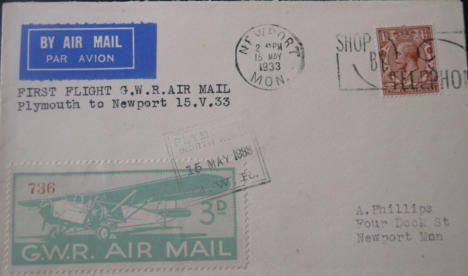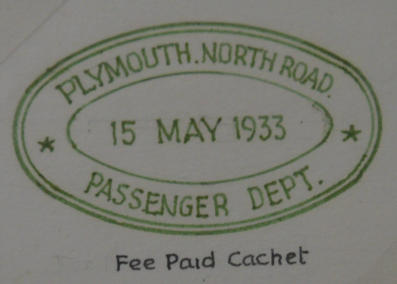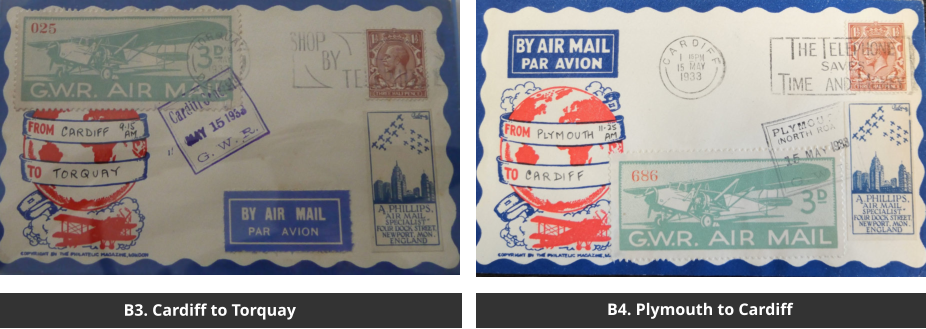
Great Western Railway - 15th May


These three envelopes give two examples of the round trip that was
flown from Cardiff to Plymouth and Plymouth to Cardiff. The above two
examples show how the envelope is normally seen. The label is
cancelled at Cardiff on the front and the return is cancelled at Plymouth
on the rear. The example on the left has only one air label and only one
cancel that of Cardiff. There is no stamp or cancel on the rear. There
were only twenty round trips flown and the signature of the pilot
(Captain Dismore) is most unusual.

B5. Plymouth to Newport.
B6. Torquay to Cardiff Dismore signed

Copyright
© 2022 Robert Farquharson All Rights Reserved
GWR (Great Western Railway). 15th May. First official airmail.
Whereas Anthony Phillips cornered the market for the ‘souvenir’ covers of the 12th April, for the first official flight he had competition. The route did not change, the plane flew from Cardiff to Haldon to Plymouth. Both Cardiff and Haldon had two booking offices which took in the mail and posted the new mail when it arrived. These were Teignmouth and Torquay for Haldon and Cardiff and Newport for Cardiff. Plymouth only used the single office. Despite the competition Phillips still secured most of the covers, having bought up every stamp that was available. In all he posted 200 covers on 6 stages consisting of the following. Cardiff-Plymouth (20), Cardiff-Teignmouth (20), Cardiff- Torquay (20), 'Torquay-Cardiff (45), Plymouth-Newport (35), Plymouth-Cardiff (35), and Round Trip (25), Very often these figures are quoted by dealers and Auction Houses as the number flown on the flight. Be clear these are the covers posted by Phillips with his name/label. With a rush of blood to the head Phillips was quite honest in 1933 in his article and admitted about another 100 were flown, principally on the Cardiff-Plymouth and Plymouth-Cardiff stages. When he wrote again in 1935, he had downgraded this assessment to ‘In addition to this 200, a few covers were carried for GWR officials and a small number from Plymouth to Cardiff for a Penarth address’. We will look at these Penarth addresses further down the page. It suited the Phillips narrative for people to take his covers as the numbers flown as it enabled him to keep the prices raised high. The numbers from Cardiff-Torquay and Cardiff - Teignmouth are probably about correct as they are the hardest to find. From what appears on the market about 1/3rd are non Phillips covers, which makes his first assessment fairly realistic and his second assessment wishful thinking. We look at the standard stages first and then look at some varieties such as the Penarth addresses.
Redgrove listed the stages with six types. This was presumed definitive from the Redgrove publication for eighty two years until 2022 when a cover in a
large lot of GWR material appeared having a Newport stamp and a Plymouth cds. It was clearly some kind of philtelic item as it had a block of eight GWR
stamps. It was addressed to a name I had not seen before and not one of the usul suspects of dealers and keen collectors. This probably explains why it
has never been seen before. So now Redgrove’s list of six items can be extended to seven, although I suspect the Newport to Plymouth cover is unique,
B1. Cardiff to Plymouth
B2. Cardiff to Teignmouth
B3. Cardiff to Torquay
B4. Plymouth to Cardiff
B5. Plymouth to Newport
B6. Torquay to Cardiff
B7. Newport to Plymouth - Not in Redgrove and unrecorded until February 2022.
`
`

B2 .Cardiff to Teignmouth

B1. Cardiff to Plymouth

B3. Cardiff to Torquay

B4. Plymouth to Cardiff

Plymouth to Cardiff oval green cachet.
Example of Plymouth green cachet.

The normal GWR cancel for Plymouth was a black rectangle with Plymouth North Road on the stamp. There was another less common cancel, which was
a green oval also stating Plymouth North Road. Now the strange thing about this cancel is that nearly all of them go the same address in Penarth, which is
a suburb of Cardiff on the Severn Estuary. The other curious thing is that none have been seen other than the 15th May. Phillips mentioned Penarth but I
have not seen it mentioned anywhere else. Only green cancel not sent to Penarth was to collector D. Glover below.

Torquay to Cardiff Error
On these covers from Torquay to Cardiff the air mail labels no 361 and 343 have been cancelled at Cardiff despite coming from Torquay. The most probable explanation is that the cover was flown from Torquay on the second return flight which departed from Haldon at 4.30 pm arriving Cardiff at 5-20 pm, a clerk seeing uncancelled labels struck them with the Cardiff hand stamp. It is interesting that both examples are 6.00 pm postmarks and the covers seen that are probably stamped are 1.00pm postmarks. So, the problems were with the later flight.

British Internal Airmails of the 1930’s



Plymouth to Cardiff oval green cachet.
Example of Plymouth green cachet.

Jackson Letter
This letter which is interesting in its own right is most important for the distinctive handwriting which identifies the writer as Sir Henry Jackson. This is most important in the discussion of the Newton Abbot extensions of 17th and 27th in ‘Later Airmails’. The hand writing connection is my opinion and one that is not generally agreed.
Letter and envelope from Sir Henry Jackson, a director of GWR to his son.

Dismore letter to his daughter.
This first flight cover from Cardiff to Torquay and onto Croydon is a letter from the pilot Captain Dismore to his daughter. Uniquely signed ‘Pilot and Daddy.’ The letter says how he thought his daughter would like the stamp.



B3. Cardiff to Torquay

B4. Plymouth to Cardiff





Plymouth to Cardiff oval green cachet.
Plymouth to Cardiff oval green cachet.

Newport to Plymouth.
The newly discovered Newport to Plymouth cover.
In March 2022 this previously unrecorded cover came up for sale in Public auction in a lot of 60 GWR items. It is a privately sent cover from the Newport dealer A. Philllipto a private customer. The problem is that it’s registered and therefore threre is no proof it was flown. This is addressed by Phillips in his handwriting to someone at the Midland Stamp Company which resided at 65 George Street.
Great Western Railway - 15th May


B5. Plymouth to Newport.
Copyright
© 2020 Robert Farquharson All Rights Reserved
GWR (Great Western Railway). 15th May. First official airmail.
Whereas Anthony Phillips cornered the market for the ‘souvenir’ covers of the 12th April, for the first official flight he had competition. The route did not change, the plane flew from Cardiff to Haldon to Plymouth. Both Cardiff and Haldon had two booking offices which took in the mail and posted the new mail when it arrived. These were Teignmouth and Torquay for Haldon and Cardiff and Newport for Cardiff. Plymouth only used the single office. Despite the competition Phillips still secured most of the covers, having bought up every stamp that was available. In all he posted 200 covers on 6 stages consisting of the following. Cardiff-Plymouth (20), Cardiff-Teignmouth (20), Cardiff- Torquay (20), 'Torquay-Cardiff (45), Plymouth-Newport (35), Plymouth-Cardiff (35), and Round Trip (25), Very often these figures are quoted by dealers and Auction Houses as the number flown on the flight. Be clear these are the covers posted by Phillips with his name/label. With a rush of blood to the head Phillips was quite honest in 1933 in his article and admitted about another 100 were flown, principally on the Cardiff-Plymouth and Plymouth-Cardiff stages. When he wrote again in 1935, he had downgraded this assessment to ‘In addition to this 200, a few covers were carried for GWR officials and a small number from Plymouth to Cardiff for a Penarth address’. We will look at these Penarth addresses further down the page. It suited the Phillips narrative for people to take his covers as the numbers flown as it enabled him to keep the prices raised high. The numbers from Cardiff-Torquay and Cardiff - Teignmouth are probably about correct as they are the hardest to find. From what appears on the market about 1/3rd are non Phillips covers, which makes his first assessment fairly realistic and his second assessment wishful thinking. We look at the standard stages first and then look at some varieties such as the Penarth addresses.
Redgrove listed the stages with six types. This was presumed definitive from the Redgrove publication for eighty two years until 2022 when a cover in a
large lot of GWR material appeared having a Newport stamp and a Plymouth cds. It was clearly some kind of philtelic item as it had a block of eight GWR
stamps. It was addressed to a name I had not seen before and not one of the usul suspects of dealers and keen collectors. This probably explains why it
has never been seen before. So now Redgrove’s list of six items can be extended to seven, although I suspect the Newport to Plymouth cover is unique,
B1. Cardiff to Plymouth
B2. Cardiff to Teignmouth
B3. Cardiff to Torquay
B4. Plymouth to Cardiff
B5. Plymouth to Newport
B6. Torquay to Cardiff
B7. Newport to Plymouth - Not in Redgrove and unrecorded until February 2022.
`
`

B1. Cardiff to Plymouth

B3. Cardiff to Torquay
Plymouth to Cardiff oval green cachet.

The normal GWR cancel for Plymouth was a black rectangle with Plymouth North Road on the stamp. There was another less common cancel, which was
a green oval also stating Plymouth North Road. Now the strange thing about this cancel is that nearly all of them go the same address in Penarth, which is
a suburb of Cardiff on the Severn Estuary. The other curious thing is that none have been seen other than the 15th May. Phillips mentioned Penarth but I
have not seen it mentioned anywhere else. Only green cancel not sent to Penarth was to collector D. Glover below.

Torquay to Cardiff Error
On these covers from Torquay to Cardiff the air mail labels no 361 and 343 have been cancelled at Cardiff despite coming from Torquay. The most probable explanation is that the cover was flown from Torquay on the second return flight which departed from Haldon at 4.30 pm arriving Cardiff at 5-20 pm, a clerk seeing uncancelled labels struck them with the Cardiff hand stamp. It is interesting that both examples are 6.00 pm postmarks and the covers seen that are probably stamped are 1.00pm postmarks. So, the problems were with the later flight.

British Internal Airmails of the 1930’s


Plymouth to Cardiff oval green cachet.

Jackson Letter
This letter which is interesting in its own right is most important for the distinctive handwriting which identifies the writer as Sir Henry Jackson. This is most important in the discussion of the Newton Abbot extensions of 17th and 27th in ‘Later Airmails’. The hand writing connection is my opinion and one that is not generally agreed.
Letter and envelope from Sir Henry Jackson, a director of GWR to his son.

Dismore letter to his daughter.
This first flight cover from Cardiff to Torquay and onto Croydon is a letter from the pilot Captain Dismore to his daughter. Uniquely signed ‘Pilot and Daddy.’ The letter says how he thought his daughter would like the stamp.


B3. Cardiff to Torquay



Plymouth to Cardiff oval green cachet.



















































